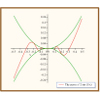Analysis Seminar
This talk concerns recent joint work with E. M. Stein on the extension to higher dimension of Calderón's and Coifman-McIntosh-Meyer's seminal results about the Cauchy integral for a Lipschitz planar curve (interpreted as the boundary of a Lipschitz domain $D\subset\mathbb C$).
From the point of view of complex analysis, a fundamental feature of the 1-dimensional Cauchy kernel:
$$
H(w, z) = \frac{1}{2\pi i}\frac{dw}{w-z}
$$
is that it is holomorphic (that is, analytic) as a function of $z\in D$. In contrast with the one-dimensional theory, in higher dimension there is no obvious holomorphic analogue of $H(w, z)$. This is because of geometric obstructions (the Levi problem) that in dimension 1 are irrelevant.
A good candidate kernel for the higher dimensional setting was first identified by Jean Leray in the context of a $C^\infty$-smooth, convex domain $D$: while these conditions on $D$ can be relaxed a bit, if the domain is less than $C^2$-smooth Leray's construction becomes conceptually problematic.
In this talk I will present (a) the construction of the Cauchy-Leray kernel and (b) the $L^p(bD)$-boundedness of the induced singular integral operator under the weakest currently known assumptions on the domain's regularity — in the case of a planar domain these are akin to Lipschitz boundary, but in our higher-dimensional context the assumptions we make are in fact optimal. The proofs rely on the “$T(1)$-theorem technique” from real harmonic analysis.
Time permitting, I will describe applications of this work to complex function theory (specifically, to the Szegő and Bergman projections on the holomorphic Hardy and Bergman spaces).
